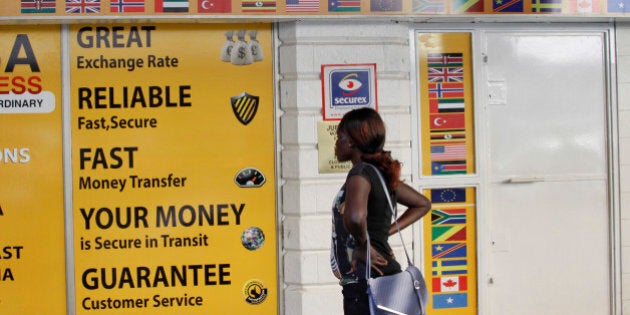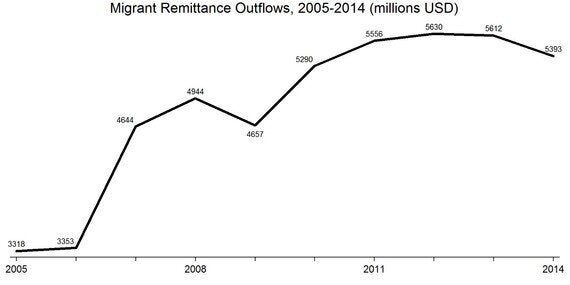
By Liam Swiss
On the cusp of the first budget of the second Trudeau-era, Canadians still await a clear indication of how the new Liberal government will engage on foreign aid and development. There have been encouraging signs: more aid to the refugee crisis; more aid to climate change adaptation; a relaxing of the adversarial approach to civil society. Still, what stamp the Liberals will place on Canadian aid and its role in our foreign policy remains a matter for speculation.
Advocates have argued for more aid, better aid, and moving beyond aid. Certainly, all such aims have their merits, but one area in the 'beyond aid' context that has received less attention is the matter of remittances.
Unlike many forms of aid or investment, remittances have the potential to rapidly affect the lives of those who receive them.
What is a remittance? Simply put, the process of sending money internationally from Canada to a friend or family member in a foreign country. Globally, the flows of remittances have grown substantially in recent years. Even with a projected slowdown in 2015, the World Bank recently predicted total remittances to 'developing countries' would exceed $435 Billion USD. To put it in context, official development assistance/foreign aid in 2014 was estimated at just over $135 Billion USD globally.
The growing gap between remittances and official aid is a telling indicator of why so many in the international development community are increasingly interested in the potential of remittances as an alternate form of financing for development. Unlike many forms of aid or investment, remittances have the potential to rapidly affect the lives of those who receive them. Surveys in several African countries show, for example, that remittances are used for everything from everyday essentials like food and shelter to starting a businesses or education fees.
Remittances certainly are not guaranteed to end up in the pockets of the poorest. Unlike aid, there is no set of conditions on remittances that require them to be spent on combatting poverty or 'development'; but emerging evidence from across the Global South suggests that remittances can play a key role in doing so. By linking communities and families in their home countries to the resources generated by migrants globally, a key foreign source of income is introduced into society.

In Canada, remittances to low- and middle-income countries have grown significantly over the past decade. Estimates from the World Bank suggest that remittance outflows from migrants to Canada topped $5.6 Billion USD in 2013 (see Fig. 1), and that total remittances from Canada to low- and middle-income countries exceeded that amount significantly (see Fig. 2).

With the extent of remittances likely to grow further, Canada needs to explore ways in which our support for development globally might build on these resources. As a private flow of funds, governments have limited opportunities to leverage remittances use for development finance.
Still, as others have argued (here & here), there are ways Canada could take innovative steps to both facilitate and amplify the effects of remittances in low- and middle-income countries.
First, Canada can do more to make its Budget 2015 promise to facilitate access lower-cost means through which to send remittances abroad a reality. World Bank research and databases show that the costs of sending remittances vary widely, with the highest costs of sending remittance often experienced when remitting to sub-Saharan Africa and East Asia.
The costs of sending money to the highest volume remittance countries from Canada also vary widely, with 2015 estimates suggesting rates higher than eight per cent for China and Vietnam or around five per cent for the Philippines. Considering the scale of remittances to these countries, these costs amount to hundreds of millions of dollars taken from the hard-earned Canadians and other immigrants.
The new Canadian government should continue efforts to reduce the cost of remittances to reduce this burden, and in a sense, increase the amount available to remit. Whether through regulating sending costs or implementing tax credits to offset fees for remittance to low- and middle-income countries, Canada should do more to facilitate remittances, wherever their destination.
Second, Canada should look to amplify the remittances its residents already send abroad to low- and middle-income countries. This would serve to increase: (1) incentives to remit, and (2) the level of remittance flows. Some form of matching remittances to eligible low- and middle-income countries would go a ways to achieving this amplification.
Many remittance receiving countries have tried to incentivize and channel remittances in this way, most notably a program in Mexico where the government matched remittances on a 3 to 1 basis, providing $3 for investment in local infrastructure for every dollar remitted. International organizations have also experimented with matching on the recipient side to encourage the use of remittances for development. Indeed, a recent study shows that remittance matching holds promise as a means to channel resources towards education.
Immigrants and diaspora groups in Canada make a central contribution to the Canadian economy and society.
To amplify remittances, Canada could fund low- and middle-income countries to establish remittance matching programs; and even target those programs to specifically leverage remittances from Canada. Such a program could be managed through Canada's foreign aid program with little difficulty. Likewise, the Canadian government could implement personal incentives through tax credits or matching grants to increase remittances by private individual remitters. Such programs could increase remittances from Canada to families and communities in receiving countries looking to expand development financing.
Central to increased support for remittances is a willingness by Canadians and our government to relax the conditions and expectations we sometimes place on our limited foreign aid funds. Increasingly, evidence from around the globe suggests that cash transfers with little or no conditions are put to good use by individuals and businesses in developing economies.
Do not get me wrong, we should not replace aid with increased support for remittances. Instead, Canada should look to supplement and diversify its support for development globally by allocating new resources to support remittances. Beyond government interventions, there is potentially a role here for community groups, associations, and NGOs in Canada to mobilize attention to the importance of remittances to development and to further expand the base of remittance funds sent from Canada in the future.
Immigrants and diaspora groups in Canada make a central contribution to the Canadian economy and society. As the level of remittances shows, in many cases, they also continue to contribute to the economic and social development of their home communities and countries. As a means of expanding Canada's support for development beyond aid, the government should look to work with Canadians and migrants alike to facilitate and amplify this increasingly important source of development finance.
(For more data on Canadian remittance flows click here)
Liam Swiss (@liamswiss) is assistant professor in the Department of Sociology at Memorial University. He researches and teaches about foreign aid, gender and development.
The views expressed in this blog are those of the authors, and do not necessarily reflect the positions of CCIC or its members.
Follow HuffPost Canada Blogs on Facebook
ALSO ON HUFFPOST:
